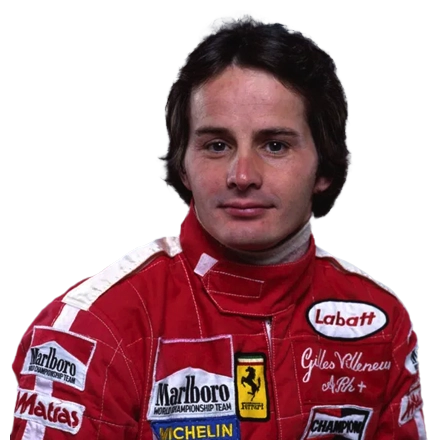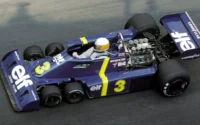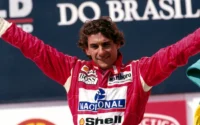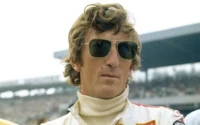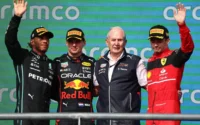Joseph Gilles Henri Villeneuve was born in Richelieu, a small town in Quebec, Canada, to an travelling piano-tuner. He grew up in nearby Berthierville.
| Nationality | Canadian |
|---|---|
| Born | Joseph Gilles Henri Villeneuve 18 January 1950 Saint-Jean-sur-Richelieu, Quebec, Canada |
| Died | 8 May 1982 (aged 32) Leuven, Belgium |
Gilles initially dabbled in music but developed a passion for cars. At 15, his father gifted him an old 1958 MGA sports car purchased for $100. Gilles stripped the car down, learning as he went, and eventually made it roadworthy despite being underage. His early driving career was marked by a series of wrecked cars, including his MGA.
After finishing school, Gilles began competing in drag racing with his modified 1967 Ford Mustang. A visit to Mont Tremblant to watch road racing convinced him he could do better than the competitors he saw. Without sufficient funds for single-seaters, he used his construction job earnings to fund snowmobile racing, eventually turning professional.
During his early career, money was tight, and Gilles primarily earned from snowmobile racing, where he was highly successful, especially after winning the 1974 World Championship Snowmobile Derby.
In 1973, he attended the Jim Russell Racing School at Le Circuit Mont Tremblant, obtaining his racing license. He had a successful season in the Quebec regional Formula Ford series, driving a two-year-old car with friends from snowmobiling. He won seven out of ten races, clinching the provincial championship on his first attempt.
In 1974, Gilles advanced to Formula Atlantic with Ecurie Canada, selling the family house to finance the drive. The family lived in a camper van, travelling together during the racing season, a practice he continued in his Formula One career.
The early races of the 1974 season were disappointing, and mid-season, Gilles crashed at Mosport Park, breaking his leg in two places. He lost his drive with Ecurie Canada and had to find funds to get a new chassis to finish the season.
His second season in Formula Atlantic was partly sponsored by Skiroule, his snowmobile manufacturer. Gilles credited his snowmobiling experience for his success, highlighting the lessons in control and reaction it provided. He won his first Atlantic race that year at Gimli Motorsport Park in heavy rain.
In 1976, partnered with Chris Harrison’s Ecurie Canada and March race engineer Ray Wardell, Gilles dominated the season, winning all but one race and securing the US and Canadian titles. That summer, Ron Dennis invited him to race a Formula 2 car at Pau, where he impressed despite the car overheating. Gilles then caught the attention of James Hunt by outperforming several Grand Prix stars in a non-championship Formula Atlantic race at Trois-Rivières. Hunt recommended him to McLaren, who signed Gilles for several races as a third driver alongside Hunt and Jochen Mass, with an option for 1978.
Gilles often claimed to be born in 1952 to appear younger for a chance in Formula One. By the time he debuted, he was 27 but presented himself as 25 to avoid age-related biases in the sport.
He made his debut at the 1977 British Grand Prix, qualifying an impressive 9th in McLaren’s old M23, splitting regular drivers Hunt and Mass. Despite a faulty temperature gauge delaying him for two laps, Gilles ran competitively, setting the fifth-fastest lap and finishing 11th. However, McLaren decided not to retain him.
In August 1977, Gilles met Enzo Ferrari, who was immediately reminded of the legendary Tazio Nuvolari. Ferrari’s interest led to Niki Lauda leaving at the 1977 Canadian Grand Prix after securing his second championship. Gilles retired from the race after going off on another competitor’s oil. He also raced in Japan but retired after a collision with Ronnie Peterson in the Tyrrell P34, which resulted in his Ferrari going airborne and tragically killing two spectators in a prohibited area.
Gilles later remarked that his three wishes would have been to get into racing, enter Formula 1, and drive for Ferrari.
In 1977, Gilles also secured a deal to race in Formula Atlantic again, facing competition from newcomer Keke Rosberg. Nevertheless, he clinched the title for the second time.
In the 1978 F1 season, Gilles was partnered with Carlos Reutemann. The season was marked by a series of retirements, often due to issues with the new Michelin radial tyres and his inexperience, as it was only his fifth season of car racing. Despite calls from the Italian press for his replacement, Ferrari persisted with Gilles, who scored his first Grand Prix victory at his home race, the 1978 Canadian Grand Prix in Montreal, to an ecstatic crowd.
In 1979, Ferrari hired Jody Scheckter as the team leader following Carlos Reutemann’s move to Lotus. Villeneuve had an impressive season, winning in South Africa and Long Beach and creating a legendary moment at the 1979 French Grand Prix in Dijon with a dramatic last-lap battle against Rene Arnoux. Despite his 312T4 being slower than Arnoux’s Renault, Villeneuve refused to concede. Arnoux passed Villeneuve with three laps to go, but Villeneuve regained the position. The final lap saw the two cars running side-by-side, making contact multiple times. Villeneuve eventually secured second place, remarking, “I tell you, that was really fun! I thought for sure we were going to get on our heads, you know, because when you start interlocking wheels it’s very easy for one car to climb over another.”
At Zandvoort, a slow puncture caused Villeneuve’s left rear tyre to collapse, forcing him off the track. He returned to the pits on three wheels, with sparks flying and the punctured tyre flapping. The tyre eventually tore away from the suspension, and Villeneuve had to be persuaded that the car was beyond repair.
At the end of the year, Villeneuve supported Scheckter’s successful title challenge, winning again at Watkins Glen. During a wet Friday practice session, Villeneuve set a time 9-11 seconds faster than any other driver. Scheckter, who was second fastest, was astonished, and Jacques Laffite quipped, “Why do we bother? Gilles is different from the rest of us. He is on a separate level.”
Villeneuve could have won the World Championship in 1979 by beating Scheckter, but he chose to follow team orders and finished behind him at the 1979 Italian Grand Prix, ending the season just four points behind in the standings.
The 1980 season was disastrous for Ferrari, with Villeneuve scoring only 6 points due to the problematic 312T5, which had poor ground effects. His world-champion teammate managed only two points and retired at the end of the season.
The 1981 Ferrari 126CK was a different story. Despite an unrefined chassis, the turbocharged engine was fast. Villeneuve won at Monaco and Spain, showcasing his skill in defensive driving. At Jarama, he held off five quicker cars to win, using his tactical acumen and the car’s superior straight-line speed. Designer Harvey Postlethwaite later commented, “In terms of sheer ability I think Gilles was on a different plane to the other drivers. To win those races on tight circuits was quite out of this world. I know how bad that car was.”
In 1982, despite a refined car, the season began with reliability problems. Villeneuve faced two retirements and a disqualification at the 1982 US Grand Prix. At the 1982 San Marino Grand Prix, amidst the FISA-FOCA war, Ferrari’s main competition was Renault. When Renault retired, Ferrari ordered its drivers to slow down. Villeneuve believed this meant maintaining positions, but Pironi passed him and won the race. Feeling betrayed, Villeneuve vowed never to speak to Pironi again.
Two weeks later, at Zolder, Villeneuve tragically died in a crash while attempting to take pole position. His death profoundly affected the sport. He became an iconic figure renowned for his car control, aggressive driving, and “never give up” attitude. Niki Lauda wrote, “He was the craziest devil I ever came across in Formula 1… The fact that, for all this, he was a sensitive and lovable character rather than an out-and-out hell-raiser made him such a unique human being.”
At his funeral in Berthierville, former teammate Jody Scheckter eulogized, “I will miss Gilles for two reasons. First, he was the fastest driver in the history of motor racing. Second, he was the most genuine man I have ever known. But he has not gone. The memory of what he has done, what he achieved, will always be there.”
In 2007, former Marlboro marketer John Hogan disputed claims that Pironi had gone back on an agreement with Villeneuve, suggesting that Villeneuve was simply stunned to be outdriven. Lap time comparisons indicated Villeneuve was saving fuel while leading.
Villeneuve’s younger brother Jacques Villeneuve Sr. had a successful racing career in Formula Atlantic, Can-Am, and CART, and his son Jacques Villeneuve became a racing driver, winning the Indianapolis 500 and the CART Championship in 1995 and the F1 World Championship in 1997.
Gilles Villeneuve Formula One World Championship career
| F1 Career | 1977–1982 |
|---|---|
| Teams | McLaren, Ferrari |
| Engines | Ford Cosworth, Ferrari |
| Entries | 68 (67 starts) |
| Championships | 0 (2nd in 1979) |
| Wins | 6 |
| Podiums | 13 |
| Career points | 101 (107)1 |
| Pole positions | 2 |
| Fastest laps | 8 |
| First entry | 1977 British Grand Prix |
| First win | 1978 Canadian Grand Prix |
| Last win | 1981 Spanish Grand Prix |
| Last entry | 1982 Belgian Grand Prix |
Gilles Villeneuve Teammates
| 6 Teammates | Involvement | First Year | Last Year |
|---|---|---|---|
| James Hunt | 1 | 1977 | |
| Jochen Mass | 1 | 1977 | |
| Niki Lauda | 1 | 1977 | |
| Carlos Reutemann | 18 | 1977 | 1978 |
| Jody Scheckter | 29 | 1979 | 1980 |
| Didier Pironi | 20 | 1981 | 1982 |
Race Wins
| Win Number | Grand Prix |
|---|---|
| 1 | 1978 Canadian Grand Prix |
| 2 | 1979 South African Grand Prix |
| 3 | 1979 United States Grand Prix West |
| 4 | 1979 United States Grand Prix |
| 5 | 1981 Monaco Grand Prix |
| 6 | 1981 Spanish Grand Prix |
Complete Formula One Results
| Year | Entrant | Chassis | Engine | 1 | 2 | 3 | 4 | 5 | 6 | 7 | 8 | 9 | 10 | 11 | 12 | 13 | 14 | 15 | 16 | 17 | WDC | Pts1 |
|---|---|---|---|---|---|---|---|---|---|---|---|---|---|---|---|---|---|---|---|---|---|---|
| 1977 | Marlboro Team McLaren | McLaren M23 | Ford Cosworth DFV 3.0 V8 | ARG | BRA | RSA | USW | ESP | MON | BEL | SWE | FRA | GBR 11 | GER | AUT | NED | ITA | USA | NC | 0 | ||
| Scuderia Ferrari | Ferrari 312T2 | Ferrari 015 3.0 F12 | CAN 12 | JPN Ret | ||||||||||||||||||
| 1978 | Scuderia Ferrari | Ferrari 312T2 | Ferrari 015 3.0 F12 | ARG 8 | BRA Ret | 9th | 17 | |||||||||||||||
| Ferrari 312T3 | Ferrari 015 3.0 F12 | RSA Ret | USW Ret | MON Ret | BEL 4 | ESP 10 | SWE 9 | FRA 12 | GBR Ret | GER 8 | AUT 3 | NED 6 | ITA 7 | USA Ret | CAN 1 | |||||||
| 1979 | Scuderia Ferrari | Ferrari 312T3 | Ferrari 015 3.0 F12 | ARG Ret | BRA 5 | 2nd | 47 (53) | |||||||||||||||
| Ferrari 312T4 | Ferrari 015 3.0 F12 | RSA 1 | USW 1 | ESP 7 | BEL 7 | MON Ret | FRA 2 | GBR 14† | GER 8 | AUT 2 | NED Ret | ITA 2 | CAN 2 | USA 1 | ||||||||
| 1980 | Scuderia Ferrari | Ferrari 312T5 | Ferrari 015 3.0 F12 | ARG Ret | BRA 16 | RSA Ret | USW Ret | BEL 6 | MON 5 | FRA 8 | GBR Ret | GER 6 | AUT 8 | NED 7 | ITA Ret | CAN 5 | USA Ret | 12th | 6 | |||
| 1981 | Scuderia Ferrari | Ferrari 126CK | Ferrari 021 1.5 V6 t | USW Ret | BRA Ret | ARG Ret | SMR 7 | BEL 4 | MON 1 | ESP 1 | FRA Ret | GBR Ret | GER 10 | AUT Ret | NED Ret | ITA Ret | CAN 3 | CPL DSQ | 7th | 25 | ||
| 1982 | Scuderia Ferrari | Ferrari 126C2 | Ferrari 021 1.5 V6 t | RSA Ret | BRA Ret | USW DSQ | SMR 2 | BEL DNS | MON | DET | CAN | NED | GBR | FRA | GER | AUT | SUI | ITA | CPL | 15th | 6 |
Sources:
- Gilles Villeneuve.Wikipedia.com
- Gilles Villeneuve. historicracing.com (Text – Gerald Donaldson)
